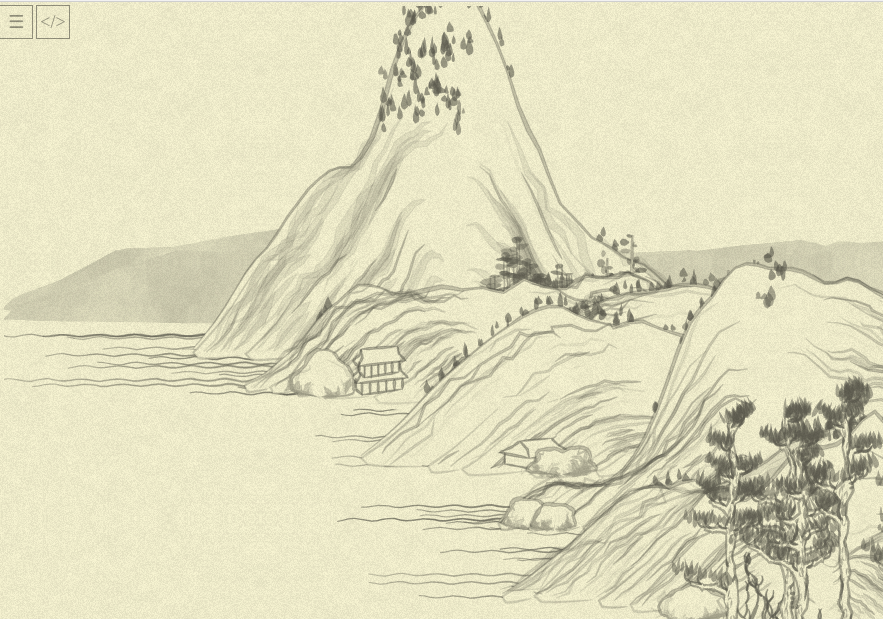Day 13: Plan for the mountains
Part of the Advent of Grok {Shan, Shui}*. See blog post for intro and table of contents.
So, let’s crack that mountplanner thing!
Random thing to spend time on:
rand(230, 280)is NOT the same as280 - rand(50)at the same step of the random generator, while looking … logically the same?… Why?.. (10 min debug). Oh, because whileMath.random()gives exactly the same value on the same step…rand(from, to)would be the same as230 + rand(50), which is NOT the same at all (just replacerand(50)with some particular value to check). So, while it is “logically nice to see”y: rand(230, 280)wherey: 280 - Math.random() * 50was, we can’t allow that!
Today would be word-low day :) After some time, I managed to mechanically simplify the main function’s body to this:
var x_range = range(xmin, xmax, xstep)
x_range.forEach( x => MEM.planmtx[Math.floor(x / xstep)] ||= 0)
x_range.forEach( x => {
var max_y = yr(x) * 480
range(0, max_y, 30).forEach( y => {
if (locmax(x, y, ns, 2)) {
var x_offset = x + rand(-500, 500);
var y_offset = y + 300;
if (chadd({ tag: "mount", x: x_offset, y: y_offset, h: ns(x, y) })) {
range(Math.floor((x_offset - mwid) / xstep), (x_offset + mwid) / xstep).
forEach( dx => MEM.planmtx[dx] += 1 )
}
}
})
if (Math.abs(x) % 1000 < Math.max(1, xstep - 1)) {
chadd({
tag: "distmount",
x: x,
y: 280 - rand(50),
h: ns(x, max_y),
});
}
})
x_range.forEach( x => {
if (MEM.planmtx[Math.floor(x / xstep)] == 0) {
chance(0.01, () => {
for (var y = 0; y < rand(4); y++) {
chadd({
tag: "flatmount",
x: x + rand(-700, 700),
y: 700 - y * 50,
h: ns(x, y),
});
}
})
}
})
x_range.forEach( x =>
chance(0.2, () => chadd({ tag: "boat", x, y: 300 + rand(390) }, 400))
)
(…as usually, I went through several hoops of “why the heck it does this now?..” but actually much lower amount than I’ve expected, and they all were trivial/seen before, so I am skipping this part.)
This new form clarifies things a bit (for me! — will I every became tired of adding this clarification?.. please imagine it everywhere), due to pure squashing of details into higher-level atoms. I enhanced our range function (which previously could only range(max)) to this:
// range(4) => [0, 1, 2, 3]
// range(1, 4) => [1, 2, 3]
// range(1, 10, 2) => [1, 3, 5, 7, 9]
function range(from, to = undefined, step = undefined) {
if(to == undefined) {
to = from
from = 0
}
step ||= 1
var res = []
for(i = from; i < to; i += step) {
res.push(i)
}
return res;
}
Funny note: here I am rather mimicking Python than Ruby (Ruby-idiomatic way to say “range with begin, end, and step” would be
(1...4).step(2)or(1...4) % 2. This is much more work to reproduce—and without a dedicated range literal Ruby has, this will still be awkward.)
There are a few more things to (slightly) clarify—more or less it looks ready-for-explanation now.
Another thing to probably notice is all cycles are replaced with range(...).forEach except for one:
for (var y = 0; y < rand(4); y++) {
chadd({
tag: "flatmount",
x: x + rand(-700, 700),
y: 700 - y * 50,
h: ns(x, y),
});
}
It cost me a dear 10 minutes of head-scratching and debugging: once you replace it with (natural, I thought, eh?) this:
range(rand(4)).forEach( y => {
chadd({
tag: "flatmount",
x: x + rand(-700, 700),
y: 700 - y * 50,
h: ns(x, y),
});
})
…the picture is suddenly screwed.
Right:

With cool range (notice the background mountains shift, and foreground trees vanishing):

…only after extracting “cycle end” to a variable for debugging I noticed/remembered my C days, and that cycle condition is calculated on every cycle run: so where with range we have exactly one call to random(), “classic” cycle re-randoms every iteration. It was probably not intended by the original author, but for the sake of preserving the exact picture I put the cycle back.
So… that’s that for today.
Tomorrow I want to tackle some of the naming, internal methods like locmax (which is obviously local_maximum, so maybe just leave it be?) and the interaction with MEM.planmtx. It is, again, not too murky (global storage of “already taken” squares of the picture), but maybe it can be more high-level, too?